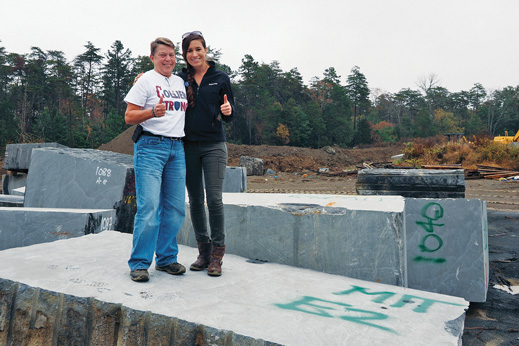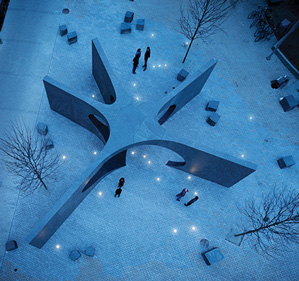MIT students love to solve puzzles. The annual Mystery Hunt, the careful execution of hacks, the uncountable research questions being tackled on campus at any given time: puzzles are an inextricable part of our culture.

Grief, however, refuses to resolve into a neatly packaged puzzle. It cannot be tackled with patience and a clever strategy. And so with the loss of MIT Police officer Sean Collier, our community had to simply settle down to the business of wallowing, processing, and accepting.
As hundreds left flowers, flags, and chalk messages near the site where he was killed, the need for a permanent memorial became evident. A memorial committee was formed with faculty, administrators, MIT Police officers, and a few of the many students who counted Sean as a friend.
When the committee first met, we were still grappling with his absence, and all we had were questions. Could we build an appropriately somber memorial and still convey optimism? What memorial would be true to Sean as his friends and family knew him, and still resonate with the MIT community generations from now?

At first, remembering Sean just meant missing him. But now it meant doing what came naturally. We had a puzzle to solve.
Our initial strategy was to ask the MIT community for ideas. We pored over every suggestion, looking for patterns. I had flashbacks to Mystery Hunts of years past. If I keep plugging away, I thought, maybe the path forward will become obvious.
Two themes emerged. Sean loved video games and learning about student research, so it was no surprise that we received many futuristic design ideas that fit the nerdy tech culture of MIT. We also got many nature-inspired submissions, reflecting Sean’s love of hiking with the MIT Outing Club. Both themes made sense, but the two suggested very different aesthetics. So, as is often the case with a tricky puzzle, our first line of attack led to yet another riddle. Can you have a design that is simultaneously sleek and outdoorsy? Something that makes you think “science fiction” but also “camping”?
We brought these questions to Professor Meejin Yoon, our unanimous choice to serve as lead architect. The massive natural stones in her final design evoked the mountains, while abstract shapes and sleek curves placed the structure firmly in the forward-looking present. The design reminded me of grieving itself: at times, it looked heavy and impenetrable, but shift just a little bit and sunlight rushed in.
With Sean’s brother Rob (who led the construction team), Professor John Ochsendorf (who worked on the stone mechanics), and the project team, we added details that turned the memorial into a puzzle for visitors to solve. The bumps installed to discourage skateboarders spell “179,” Sean’s MIT badge number, in Braille. The only closed-off arm of the memorial is aligned with the location of Sean’s cruiser on the night of April 18, 2013. The lights embedded in the ground echo the constellations above him at the moment he died.
The construction of the memorial was its own challenge. In a made-at-MIT marriage of ancient engineering tradition with modern computational techniques, the five-armed arch was to be a true arch, supported only by the forces of the stones against each other. This required Meejin and John’s teams to work overtime, double-checking calculations and recalibrating plans. Meanwhile, Rob’s team faced three blizzards and a fast-approaching deadline, necessitating strategic use of tents, shovels, and the occasional clear-weather day.
Sometimes, it was suggested that we change our plans to make the memorial easier to build. Add supporting steel cables inside the stones instead of endlessly calculating the precise geometries required to achieve the perfect arch. Forget the ambitious deadline, ride out the blizzards, and start again in the spring. Use a cheat code. Change the constraints. Make it easier.
Each time, the project team refused. A completed memorial was our end goal, but we were inspired by the process of building it, with teamwork and cleverness and committed passion for the work. We built the memorial because we needed to remember Sean. But solving the puzzle for him—that was all love.
Sara Ferry ’11, a grad student in nuclear science and engineering, served on the memorial committee organized to honor Officer Sean Collier, who was killed at MIT by the Boston Marathon bombers.
Keep Reading
Most Popular
Large language models can do jaw-dropping things. But nobody knows exactly why.
And that's a problem. Figuring it out is one of the biggest scientific puzzles of our time and a crucial step towards controlling more powerful future models.
The problem with plug-in hybrids? Their drivers.
Plug-in hybrids are often sold as a transition to EVs, but new data from Europe shows we’re still underestimating the emissions they produce.
Google DeepMind’s new generative model makes Super Mario–like games from scratch
Genie learns how to control games by watching hours and hours of video. It could help train next-gen robots too.
How scientists traced a mysterious covid case back to six toilets
When wastewater surveillance turns into a hunt for a single infected individual, the ethics get tricky.
Stay connected
Get the latest updates from
MIT Technology Review
Discover special offers, top stories, upcoming events, and more.